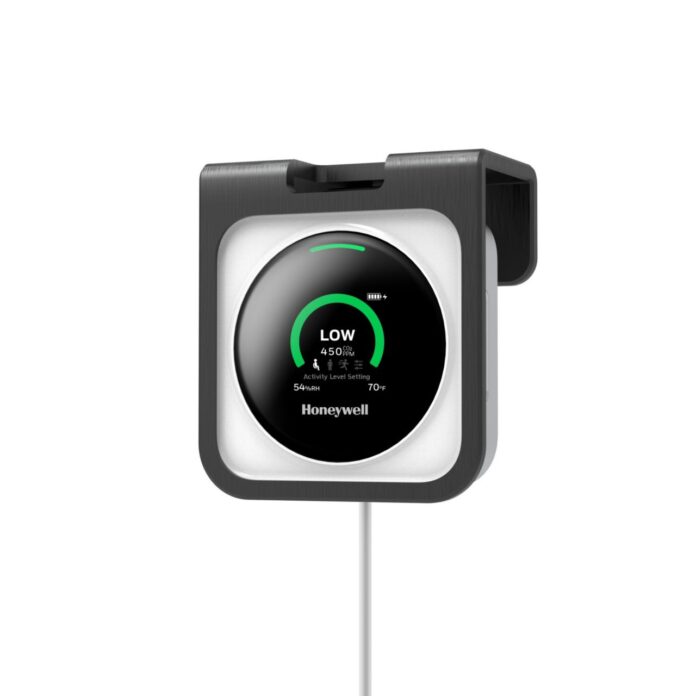- Monitors carbon dioxide and features proprietary risk alert system for use in schools, restaurants and other indoor spaces
- Alerts users to take steps to proactively improve indoor air quality to help decrease the potential risk of transmitting airborne viruses among building occupants
Honeywell (Nasdaq: HON) announced a new, user-friendly monitor that alerts users when indoor air conditions may present an increased risk of potentially transmitting airborne viruses in schools, restaurants and other spaces.
The Honeywell Transmission Risk Air Monitor is an easy-to-deploy, portable device that measures carbon dioxide and features a proprietary risk alerting system based on user-selected activity levels within a room. This helps customers be aware of when to proactively improve indoor air quality, which according to the U.S. Centers for Disease Control and Prevention, can help reduce the spread of certain diseases and decrease the risk of exposure among building occupants.
The new monitor incorporates a proprietary algorithm developed by Honeywell based on research conducted at the University of Colorado on the influence of aerosols on the transmission risks of airborne viruses. Users are alerted when conditions are present that indicate a certain air risk factor level is reached so they can increase ventilation with outdoor air and/or improve air filtration, which the U.S. Environmental Protection Agency recommends as important components of a larger strategy for indoor air quality.
“The importance of indoor air quality isn’t going to go away once we have the pandemic behind us. People are more aware of and cognizant to the potential impact that indoor air quality can have on well-being and productivity,” said Mary Furto, Chief Marketing Officer of Honeywell’s Gas Analysis and Safety business. “Our monitor provides an efficient and simple way for users to be alerted if their indoor spaces present increased risk factors by analyzing breathable air. This can enable users to understand when to take appropriate actions such as increasing ventilation in a room.”
Honeywell’s monitor uses CO2, temperature and humidity sensors and offers three pre-programmed activity level settings. It features a green, yellow or red light to alert users about the potential for increased indoor air risk factors. It incorporates an easy-to-read digital display, a rechargeable battery and is Bluetooth®*- and WiFi-enabled to allow for connectivity between the device and its mobile application and online dashboard.
Depending on the number of devices an individual or organization uses, Honeywell created unique user experiences to easily monitor certain indoor air risk factors. For schoolteachers or small business owners who use one or a few monitors, they are encouraged to use the Transmission Risk Air Monitor application from a mobile device. For organizations with several monitors, such as schools or school districts, they can access an online dashboard to monitor certain indoor air risk factors across devices from one centralized location.
Scientific evidence suggests using air monitors1 to measure indoor environmental air can be an efficient method2 to assess the potential risk and exposure to airborne viruses, which can fluctuate based on CO2 concentration levels and how active people are in a space.
“Our research has shown a close correlation between the likelihood of transmitting airborne viruses and increased carbon dioxide levels. Effective monitoring solutions can indicate that fresh air is sufficient and circulating properly in an enclosed space,” said Jose-Luis Jimenez, Professor of Chemistry and CIRES Fellow, University of Colorado-Boulder. “Our recommendation is to display a real-time carbon dioxide monitor in all public indoor spaces so people can learn quickly what environments are safer or less safe for a given activity. Going forward these monitors can be useful as a metric of indoor air quality to indicate when conditions could present an increased risk of exposure to airborne viruses.”
In addition to potentially reducing risk of exposure to airborne viruses, indoor air quality adjustments can be beneficial for student health and academic performance. While adverse effects have been reported for elevated levels of CO2 in classrooms, studies have shown that increasing ventilation can help students with decision-making, attention, concentration and memory.3
For more than 50 years, Honeywell has developed innovative gas detection solutions and analytics software to protect workers in challenging conditions across a wide range of industries. The company’s portable BW SOLO CO2 detectors are being used by workers handling large amounts of dry ice to package and ship certain COVID-19 vaccines.
The Honeywell Transmission Risk Air Monitor complements Honeywell’s Healthy Buildings solutions, which integrate air quality, safety and security technologies along with advanced analytics to help building owners improve the health of their building environments, operate more cleanly and safely, comply with new guidelines, and help reassure occupants as they return to the workplace. Honeywell has an advanced indoor air quality portfolio that can help improve occupant well-being, meet energy efficiency goals, and importantly, change the way that occupants experience a building.
The Honeywell Transmission Risk Air Monitor (HTRAM) analyzes specific air quality conditions and alerts the user when conditions are present that may increase the risk of exposure to airborne viral transmission. It does not prevent or reduce virus transmission nor mitigate viruses that may be present, nor does it detect or warn against the presence of any virus, including but not limited to COVID-19. The HTRAM does not repel or destroy any microorganism, viruses, bacteria, or germs.
Honeywell Safety and Productivity Solutions (SPS) provides products, software and connected solutions that improve productivity, workplace safety and asset performance for our customers across the globe. We deliver on this promise through industry-leading mobile devices, software, cloud technology and automation solutions, the broadest range of personal protective equipment and gas detection technology, and custom-engineered sensors, switches and controls. For more information, please visit: sps.honeywell.com.
Honeywell (http://www.honeywell.com) is a Fortune 100 technology company that delivers industry-specific solutions that include aerospace products and services; control technologies for buildings and industry; and performance materials globally. Our technologies help aircraft, buildings, manufacturing plants, supply chains, and workers become more connected to make our world smarter, safer, and more sustainable.
* Bluetooth is a trademark of the Bluetooth Special Interest Group.
1 Exhaled CO2 as COVID-19 infection risk proxy for different indoor environments and activities, Sept. 2020
2 Monitoring carbon dioxide to quantify the risk of indoor airborne transmission of COVID-19, April 2021
3 Foundations for Student Success – How School Buildings Influence Student Health, Thinking and Performance, Jan. 2021












































